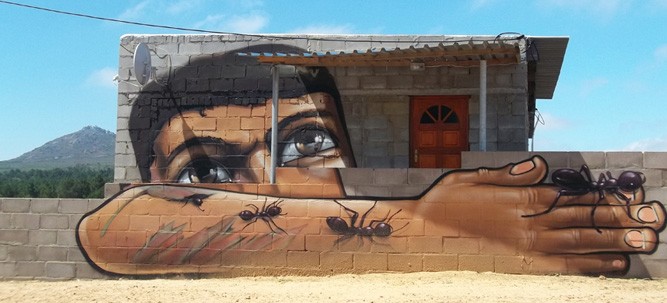Mention the word ‘graffiti’ and most people pull a face and grumble about gangs marking their territory with silly images and tags they don’t understand or how youths running wild with spray cans defacing public spaces and private property is a sign of modern society gone bad. Yet graffiti has actually been around for millions of years. The Romans wrote on the walls of buildings they conquered. Bushmen drew illustrations on cave walls that are marveled at today. And let’s face it, who didn’t draw on their walls at home with a crayon at some point in their childhood years? By nature, most of us are drawn to writing or painting something on a wall. Some just do it better than others.
To me, some of the greatest artists in this world are graffiti artists. I am not talking about the gang tags or strange scribblings that we see under bridges or on alleyway walls. I am talking about those that have taken street art to the next level. The ones who create pieces of fine art that grab our attention while bringing colour and brightness into an otherwise drab city space. Some of them make you smile and some make you think. But the one thing that gets me every time is that every intricate detail, every shadow and every expression is done using spray cans of paint. Painting a giant mural using rollers and a paintbrush is skillful enough, but to be able to command a spray can with such precision and vision is a talent known to very few. Recently, I was lucky enough to spend a few hours with Falko One, an exceptionally talented graffiti artist who’s work you have probably seen around Cape Town.
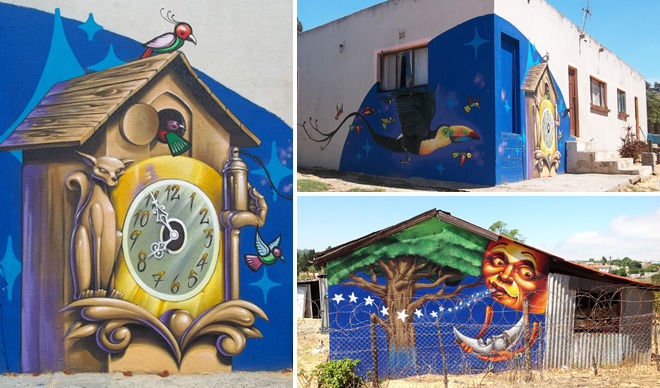
Last year Falko One teamed up with another incredibly talented artist, Rasty, to start work on a project called Once Upon a Town. Their vision was to create a total of 40 wall pieces in the West Coast towns of Darling, Mamre and Pella. The idea behind the project is to create murals on walls of homes that will encourage tourists to visit these otherwise overlooked towns and eventually involve more cities and towns across the country. Each mural is truly South African and a testament to the diverse country we live in. One of the other objectives of this project was to involve the local community by allowing them to be actively involved in the creation of each piece and they could also attend community workshops where they would be encouraged to express themselves (and perhaps one day earn a living from) using a spray can of paint.
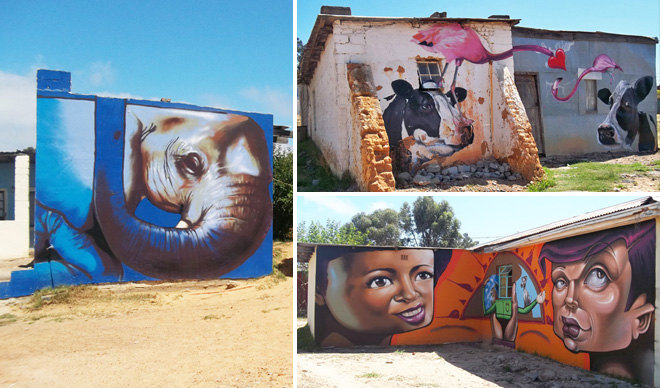
I met with Falko in Pella, which was our first stop on my Once Upon a Town personal tour. I had never heard of Pella before and was a bit alarmed at the thought of going all the way out to the Northern Cape! But it turns out that this little town is just outside of Atlantis, which about an hour’s drive from Cape Town on the R27 (West Coast road). The sign to Pella is as basic as the town itself – look out for it pinned onto a gum tree just outside of Atlantis! While I was waiting for my esteemed guide to arrive I parked outside the Moravian school (as instructed) and had a few concerned locals inquire after my well-being. I obviously looked out of place in my smart little red car! But not once did I feel unsafe – I had a friend remark, “Oh, be careful out there, that’s gangland territory” when I told her of my impending mission. As Falko pointed out to me later, there are gangs in Cape Town and most people are happy to go out there! All that is required in these small towns who seldom see strangers in nice cars is some common courtesy. Say hello, smile and simply acknowledge the person and you will be welcomed.
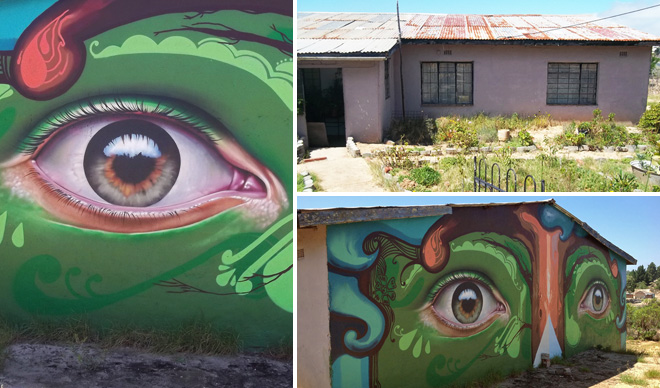
After a short drive we took a walk down the street where eleven of the murals reside. They are on the sides of houses (one of which proudly boasts four doors) and on the wall of the Pella Mini Market – which incidentally is a good spot to grab a cold drink if it’s a hot day. I felt a bit silly during the walk as all I could say was “oooh” and “aaaahhhh”, or “wow, that’s amazing”. To be honest I was gobsmacked. There in this little town, that I hadn’t even heard of before, were some of the most incredible pieces of art I had ever seen. Painted on houses that are over 100 years old! From dairy cows to laughing moons, heart-headed flamingos and blue elephants to a ladybird in a hand and ants running down an arm. I couldn’t decide on a favourite piece, but what I did notice the most was the near-reality of it all. You almost wanted to reach out and touch the soft, moist nose of the cow and you could see the reflection of the sky in the hauntingly real eyes on another wall. The best part was not knowing what I was going to stumble across next. All the houses appear to be standard old homes in a rural town, with the exception that as you pass one, something bold and bright will catch your eye. It was like a mural treasure hunt!
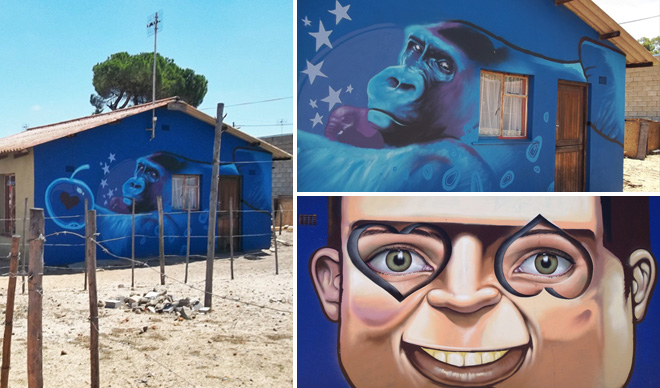
A short drive took us to the mission town of Mamre, where I was introduced to a woman called Lizelle “who lives in the panda house”. How lucky is she I thought! I would love to live in a house with a bright orange-backed mural of two people with cute fat pandas and cheeky penguins sitting their outstretched arms. (Incidentally, I can. Falko does murals in homes from R5 000). Further along the road was an impressive blue-backed mural with a life-like gorilla. There was a giraffe with tiny wings on a crumbling home, that would eventually collapse in time, taking its art with it.
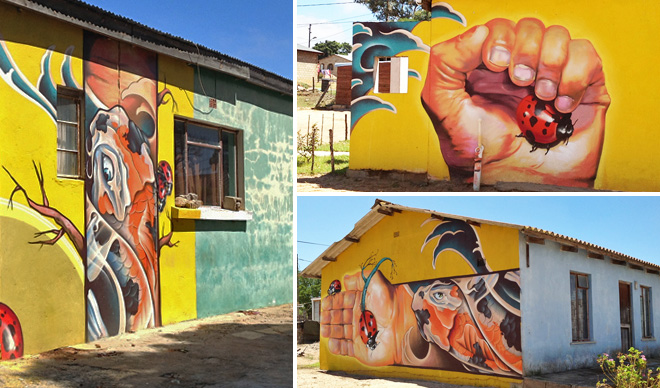
It was at about this point that Falko would stand in front of a piece and look at me expectantly. He had mentioned his Split Piece Project (started in Darling) and was waiting for me to piece the artwork together. Literally. Falko is the only graffiti artist in the world to do split-pieces, whereby one piece of the painting is on one building and the other half (or some cases, third) is on another. Some of them are reasonably obvious once you realize what’s what, but some are a little more obscure. Take a closer look at the ladybird pieces. Two of them are in Pella and one is Mamre. Put them together and you have one picture out of three separate ones. The missing head of the flamingo in Pella turns up on a wall in Mamre. Once you spot it, you’ll feel quite victorious. I certainly did!
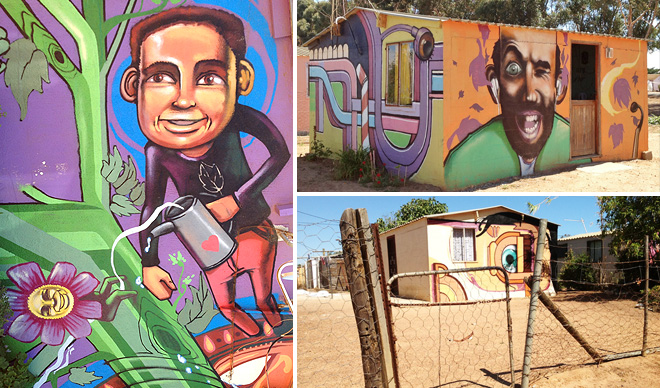
Falko and I parted ways in Mamre and I went on to Darling on my own to explore a street that had a Falko and Rasty makeover in 2011. Nearly every single little house in the block had it’s own special outdoor wallpaper. Daisies beamed at me behind garden gnomes, a window peered out from beneath a swan’s wing and sunflowers grew in front of a big-eyed owl. On my walk back to my car I started working out how long it would take me to save up R5 000 to afford a daisy mural of my own!
According the Oxford Dictionary, graffiti means “writing or drawings scribbled, scratched, or sprayed illicitly on a wall or other surface in a public place”. Thankfully not all graffiti is against the law. Without it and the talented people who create these masterpieces, unknown rural towns and dreary city spaces would be just that.

Do your own Once Upon a Town graffiti tour
Take a day trip and see these fantastic pieces of art. Start in Pella (just outside of Atlantis), drive on to Mamre and make your final stop in Darling. You can get refreshments from small street cafes in Pella and Mamre and then have a bite to eat in Darling. It could be the perfect art-day-out. You’ll be supporting the local community too.
When you get to Pella drive past the Moravian school (on your left as you enter the town) and take the first left at a stop street. Just before the Pella Mini Mart turn right (there’s a bus stop near the corner) and park your car. Take a walk up the road and see what you find. In Mamre you turn into Frans Street off the Main Road. We parked opposite the panda mural (you can’t miss it) and took a walk up the street to discover gorillas and winged giraffes. The pieces in Darling are easy to find. From Evita Bezhuidenhout Avenue turn into Disa Avenue and the first road right is Akkerboom Street. You can’t miss it.
Don’t stress if you get a bit lost, the locals will only be too happy to point you in the right direction if you ask.
